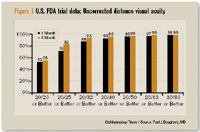Article
Accommodating IOL enhances near vision, according to phase III trial
Interim results from a phase III study evaluating an accommodating IOL (Tetraflex [KH-3500], Lenstec) for pseudophakic correction after cataract surgery demonstrate that it provides good near and distance uncorrected visual acuity outcomes along with a favorable safety profile.

Key Points

"I have been involved with this IOL for 15 months, and since it is still investigational, I am disappointed whenever I can't use it in a patient undergoing refractive lens exchange. Once the [accommodating lens] is approved, it will definitely be my presbyopic IOL of choice," said Dr. Dougherty, phase III study investigator, a private practitioner in Los Angeles, and assistant clinical instructor of ophthalmology, Jules Stein Eye Institute, University of California, Los Angeles.
The implant is a highly biocompatible lens constructed of polyHEMA. Dr. Dougherty described it as "a monofocal lens with benefits."
Lens design
The IOL was designed to provide enhanced distance and near vision with less dependence on spectacles. It is an anteriorly vaulted flexible lens without hinges. Although the exact mechanism of action is not clearly defined, it is believed that one mechanism of accommodation is through its anterior movement, which occurs in response to ciliary muscle contraction-induced pressure changes in the vitreous and anterior chamber.
"Imaging with ultrasound biomicroscopy confirms anterior movement of the lens and shows some optic deformation that is consistent with the finding from ray-tracing aberrometry of induced coma. Coma also is a natural mechanism of accommodation," Dr. Dougherty said.






